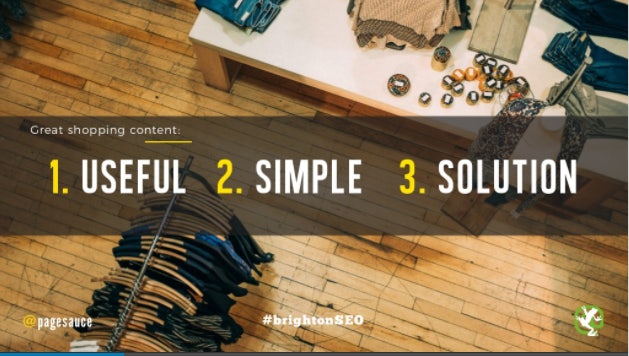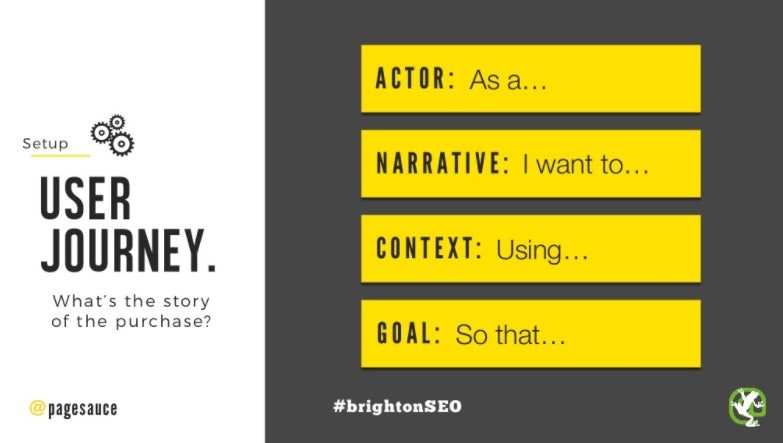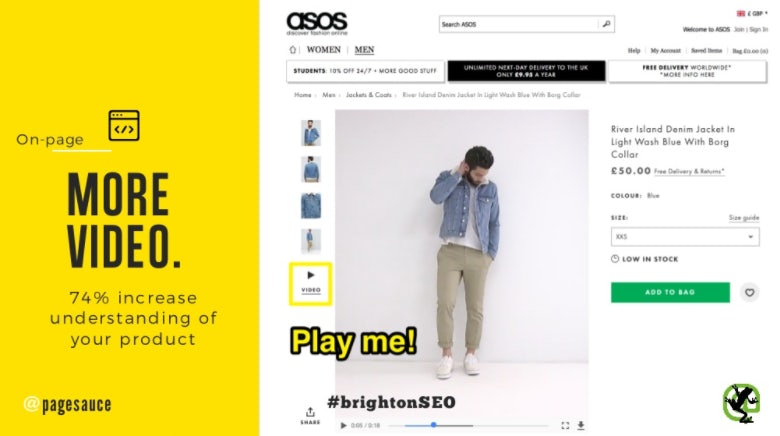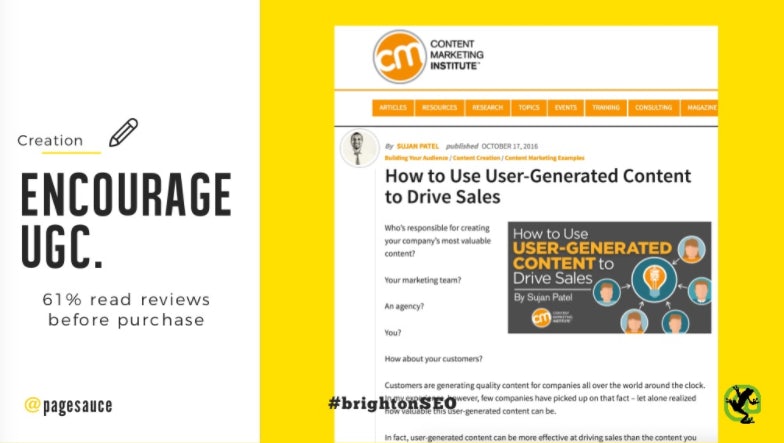Charlie Williams (@pagesauce) of Screaming Frog kicked-off BrightonSEO’s Ecommerce session by sharing tips, tactics, and tricks for creating better content for ecommerce sites.
The slides from Charlie’s presentation can be found here.
Ecommerce content: SEO considerations
Charlie began by outlining the SEO considerations to be made when planning content for ecommerce product and service pages.
Layout & Staff
He used the effective analogy of the layout and staff of an offline store to describe the ideal structure for an ecommerce store.
Layout being the technical SEO and site architecture.
Staff being the content of the ecommerce site, which speaks to the user and guides them through their purchasing journey, helping them to understand and purchase
We were reminded that a staff is always needed, even in the Amazon shop!
According to Charlie, great shopping content should be three things:

Ecommerce content: set up
With that trio in mind, Charlie offered the following checklist for creating ecommerce content:
Content strategy
Decide on the governance of content – who writes it, who edits it and how will it be published?
Find an editor
But they don’t need to be evil!
Content inventories
Charlie believes that these are underused in tech SEO – content inventories show what’s working, and which product pages aren’t providing a good shopping experience.
Learn from the market
Build a picture of what works by conducting gap analysis. Can you target synonyms and variants? How can landing pages be improved?
Templates
Create two templates: one for the product page and one for the product info section of this page.
Personas
Charlie stated the importance of knowing who you’re writing for: ecommerce must have a target.
Topics not just keywords
..because intent is as important as volume.
User journey
Charlie provided this framework for thinking about the purchase story that you are writing.

Answer Intent
What is the user’s goal?
What info, format & experience meet that goal?
Content render
How is the content seen by Google?
Structure
Charlie talked through using schema and semantic markup to make the most of the product information available to you.
Speed
Charlie had some great stats on the benefits of getting faster and catering to those shopping on mobile. He also referenced ebay’s AMP site.

Advanced on-page
Charlie emphasised the importance of co-occurrence and TF-IDF to ensure that all terms in the coffee machine conversation are covered, for example.
Images and video
Charlie is a believer of getting your own images of the products and making them the very best they can be on your budget.

Common FAQs
In Charlie’s words: “Remove friction by addressing issues”. Answer FAQs on the product page, don’t make the user find your FAQs page.
Ecommerce content: creation
When it comes to creating the content, Charlie has the following recommendations:
Become Expert
…and fake it until you make it. Charlie suggests finding the people in your business that know the products like the back of their hand and use this knowledge in your content.
Don’t ask via email, ask them over a coffee. What are the most frequent FAQs?
Software
Write in a collaborative way to gain knowledge, whether that’s through Google Docs, airstory or GatherContent.
Supplied descriptions – use them, to an extent….
Charlie recommends using the manufacturer’s description below your content, which might focus on user intent rather than product details.
User question tools
Charlie suggests the use of tools to “find the shopper’s language” and then answering their questions within product page content.
These tools included Content Forest and Answer The Public.
Q&A and FAQs
In Charlie’s words: “Find the questions people can’t Google an answer for”.
In a similar way, Quora, Amazon Customer Question and Answers, other forums, competitor FAQs can be mined to find out how about people talk about your products and the topics that they discuss. This will enable copywriters to join the conversation with a human voice.
Better Meta
Optimise meta descriptions to raise CTR.
Ask the audience
….for their problems and queries, there’s no better way to find out. Charlie suggests surveying users or meeting real people to ask them about products and services.
Encourage UCG
Such as testimonials, reviews, and third party influencer reviews.

Sell the USPs
You have chosen to create a separate product page, so what makes the content different?
Sell benefits not features
Charlie reminded the room that users buy their story, not the product.
Knowledge base
Create helpful product content by creating a simple product page with links to further knowledge pages.
Develop a style
Charlie noted the importance of writing in a brand voice – e.g. Apple focuses on how product makes the user feel.
Emotion and logic
Charlie recommended the GetUplift blog and CopyHackers resources to improve your writing for emotion, logic and conversions.
Word count
According to Charlie, top pages have 25% more content.
Final thoughts…
Charlie finished by reminding us that we are a nation of shopkeepers and that content is our way to be unique.
Creating better content is to provide a better user experience that is designed to meet intent.





